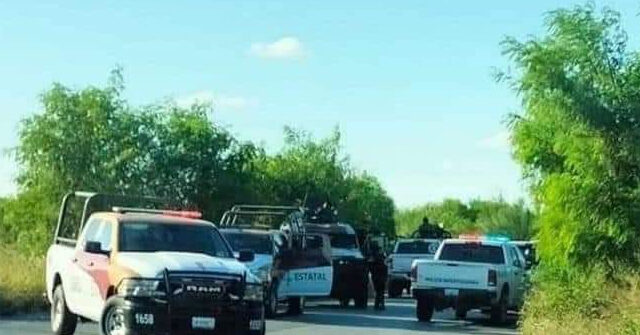In Matamoros, a border city in Mexico, local college students found themselves in a state of panic as gunfire erupted between cartel gunmen and Tamaulipas state police. This violent clash occurred on a Wednesday afternoon near the highway linked to Reynosa, and involved armed cartel members in various vehicles, including an armored truck. The situation escalated quickly, resulting in a brief yet intense firefight that left students from the nearby Universidad Autónoma de Nuevo León (UANE) scrambling for safety. The incident was recorded and shared on social media, showcasing the dangerous reality faced by civilians in regions affected by cartel violence.
Official reports indicate that four cartel gunmen were killed during the confrontation, with three others apprehended by authorities. In addition to the arrests, law enforcement seized an armored vehicle and several weapons from the scene. Following the gunfight, state investigators took measures to close down the highway connecting Reynosa and Matamoros for around two hours to properly document the crime scene and clear the area. The abrupt nature of the violence not only highlights the persistent threat posed by organized crime but also raises questions about public safety, particularly in areas frequented by students and families.
This shootout unfolds just two days after Jose Alberto Granados assumed office as the new mayor of Matamoros. Observers are now questioning whether Granados will take a strong stance against cartel-related violence or follow in the footsteps of his predecessor, Mario “La Borrega” Lopez, who faced criticism for his perceived inaction and possible complicity in cartel affairs. Under Lopez’s administration, it was alleged that members of the Gulf Cartel held significant positions within the local government, exemplified by figures like Pedro “El Polaris” Hernandez Quiroga, a convicted cartel member who became a top emergency services official after his release from prison.
The influence of the Gulf Cartel extends beyond political appointments; it recently garnered international attention for its involvement in a kidnapping case earlier this year, where U.S. citizens were taken and subsequently moved in city ambulances to a local clinic. In this alarming incident, two of the kidnapped victims lost their lives, casting a spotlight on the cartel’s reach and operations within Matamoros. Although some gunmen were surrendered and a public apology issued by the Gulf Cartel, the limited accountability raises concerns regarding the effectiveness of law enforcement in addressing cartel violence and protecting residents.
The actions of the newly elected mayor and his administration will be crucial in determining the future of security in Matamoros. If Granados chooses to prioritize transparency and accountability, he may help restore some level of order and safety for community members, including students attending nearby educational institutions. Conversely, if he opts for silence or complicity, the cycle of violence and intimidation could persist, further embedding the cartel’s grip on the community. The circumstances surrounding the recent shootout serve as a chilling reminder of the pervasive threats that civilians face in regions plagued by organized crime.
As observers continue to monitor events in Matamoros, journalists and advocates emphasize the importance of addressing drug cartel violence in Mexico through a multifaceted approach, combining law enforcement, community engagement, and political accountability. The responsibility lies with both local authorities and federal governments to ensure the safety of citizens and disrupt the operations of criminal organizations. The outcome of this situation will likely have significant implications not only for Matamoros but also for the broader context of the ongoing struggles against drug cartels within Mexico’s socio-political landscape.

